Equipment for Construction and Mining: Services and Sales Guide
From earthmoving on construction sites to lifting at ports, equipment in this category keeps global projects moving. Understanding how services, sales channels, and lifecycle decisions work helps buyers, operators, and fleet managers make safer, more cost‑effective choices across industries.

Across construction, mining, agriculture, and logistics, large equipment powers critical operations that shape infrastructure and supply chains. Choosing the right models, maintaining them properly, and deciding whether to buy, lease, or outsource are decisions that affect safety, uptime, and total cost of ownership. This guide explains how heavy machinery services function, what to expect from sales processes, and how to evaluate machines for long-term reliability and compliance in your area and beyond.
What do heavy machinery services cover?
Service providers typically offer a continuum of support that starts before delivery and extends throughout the machine’s life. Common elements include installation and commissioning, operator training, scheduled maintenance, and emergency repairs. Many companies add predictive maintenance using telematics to spot issues early—oil analysis, vibration monitoring, and fault-code trend reviews—to reduce unplanned downtime. For fleets working in harsh conditions, mobile service units shorten response times and keep utilization high.
Support increasingly includes data services. Telematics portals aggregate fuel burn, idle time, and load factors, helping managers optimize assignments and cut waste. For companies operating mixed fleets, multi-brand diagnostic capabilities matter; they enable consistent service standards regardless of manufacturer. In regions with limited dealer coverage, service contracts with guaranteed response windows provide assurance, especially for critical-path equipment like cranes or large excavators.
How heavy machinery sales operate
Heavy machinery sales involve multiple channels: authorized dealers, manufacturer direct, auctions, and private sellers. Dealers and OEM outlets usually provide manufacturer-backed warranties, financing options, and parts availability, which can be valuable for high-utilization fleets. Auctions and private sales may offer lower upfront prices, but buyers should perform rigorous inspections, verify serial numbers, check service logs, and test under load to confirm performance.
Financing is often structured around the asset’s expected residual value and duty cycle. Buyers compare loan terms, operating leases, and finance leases, considering seasonal workloads and projected resale timing. Extended warranties, maintenance bundles, and buy-back agreements can simplify ownership forecasting. For global projects, confirm compliance with local emissions and safety regulations at the destination market to avoid delays at customs or during site mobilization.
Heavy machinery selection tips
Start with the job profile: material type, required capacity, cycle time, terrain, and duty rating. Match engine power and hydraulic performance to the heaviest expected workload, not just the average task. Attachments—buckets, breakers, grapples—should be compatible with quick-couplers and meet OEM specifications to avoid undue stress. Evaluate visibility, cab ergonomics, and control layouts because better operator comfort improves productivity and reduces fatigue-related incidents.
Lifecycle considerations affect total cost. Look at component rebuild intervals, parts commonality across models, and dealer network density. Telematics readiness, over-the-air updates, and remote diagnostics reduce service visits. Fuel efficiency varies widely by operating mode; test machines under real site conditions, including idling policies and auto-shutdown features. Safety systems—proximity detection, 360-degree cameras, and load-moment indicators—are increasingly standard and can support compliance programs.
Heavy machinery services for uptime
Planned maintenance aligned with manufacturer intervals is essential, but adapting schedules to local conditions—dust, humidity, altitude—improves outcomes. Greasing points should be accessible; auto-lube systems are helpful for machines with continuous cycles. Keep critical spares on hand: filters, belts, wear parts, and hydraulic hoses. A structured pre-shift inspection routine reduces failures; digital checklists with photo capture provide traceability for audits and warranty claims.
When seeking local services, verify technician certifications, tooling (including diagnostic software), and access to genuine parts. Ask about response times, loaner equipment policies, and availability during peak seasons. For remote sites, satellite communications and offline diagnostic workflows enable faster triage. Clear service-level agreements with measurable KPIs—first-time fix rate, mean time to repair, and preventive maintenance completion—help ensure accountability.
Heavy machinery sales and sustainability
Environmental performance is shaping procurement decisions. Stage/Tier emissions compliance, aftertreatment reliability, and access to low-sulfur fuels influence both operating costs and legal compliance. Some fleets test alternative powertrains, such as hybrid or battery-electric models, for specific duty cycles like indoor material handling or short-shift urban work. Where electrification isn’t practical, fuel-saving strategies—right-sizing machines, reducing idle, and optimizing haul roads—deliver measurable gains.
End-of-life planning matters. Machines with strong secondary markets or factory-supported rebuild programs retain value. Documented maintenance histories, software update records, and parts traceability increase buyer confidence during resale. If exporting used equipment, confirm destination import rules on age limits, emissions, and certification to prevent costly returns.
Safety, compliance, and training
Consistent operator training underpins safe, efficient operations. Programs should cover load charts, ground conditions, signaling, lockout/tagout procedures, and site-specific hazards. Refresher courses after incidents or equipment upgrades keep teams aligned. Supervisors can use telematics data to coach on best practices—reducing harsh braking, over-speeding, or overload events.
Regulatory frameworks vary worldwide, but core expectations are similar: documented inspections, maintained safety devices, and clear records of corrective actions. Establish a culture where defects are reported promptly and repairs are verified before returning machines to service. Coordinated planning between operations, maintenance, and safety teams supports higher uptime and fewer incidents.
Conclusion Reliable performance depends on choosing the right machine for the job, setting up strong service support, and making informed sales decisions. With sound inspections, data-driven maintenance, and attention to safety and regulations, organizations can improve productivity while extending asset life and preserving resale value across diverse operating environments.




